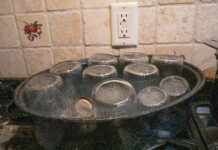AMARILLO, Texas – Willie Wieck’s farm in Etter, Texas, has a little bit of everything – wheat, cotton, seed maize, black-eyed peas, sunflowers, pumpkins, gourds, cantaloupes, watermelons, popcorn and sweet corn.
And, he knows how to sell it. With a diverse operation, marketing is what makes the difference in the bottom line, Wieck said.
A graduate of Texas Cooperative Extension’s Master Marketer program, he told a recent class that the program helped him find different ways to approach marketing.
Fresh market. For instance, with sunflowers, the market is open the first two months of the year, he said. That’s when the sunflowers are bought, and only an emergency will open it back up.
Of the 4,800 acres Wieck farms, more than half are sunflowers. While he grows for the commercial market, his wife Mildred grows a 25-acre garden for the fresh market, Wieck said.
Through the combined operations, Wieck’s produce has been sold from the back of a pickup truck at a farmers’ market, from the Wiecks’ own store in the tiny town of Etter – population 200 – and through Wal-Marts on the West Coast and grocery chains on the East Coast, he said.
Five pounds of black-eyed peas to a farmer under a commercial contract will earn about $1. If he sells fresh and direct to the public, the same 5 pounds in worth almost $20.
His wife doesn’t grow black-eyed peas in the garden, but Wieck said some of his 250 acres of black-eyed peas will go through the fresh market with the rest of her garden produce to take advantage of that higher price.
Using the same approach, a bushel of wheat will sell for $4 on the commercial market, while that same wheat ground into flour and sold in the fresh market will bring $60, Wieck said.
Farm store. It’s different when people drive all the way to Wieck’s store in Etter than if they were going to the grocery store, he said. If they have extra money, they’re going to spend it before they leave. That’s why there are bags of fresh popcorn meal, wheat flour and popcorn on the counter.
“It’s a marketing thing,” he said.
Wieck invested in a pea sheller, a grinder and a vacuum packaging machine. All have easily paid for themselves. The counter clerks at the small store run the machines while they wait for customers, and the fresh aroma helps sell produce.
“It’s amazing to me how many people order a couple of bushels, and if that machine is running, they’ll order a couple more because of the smell,” Wieck said.
Entertainment. Another thing he’s learned along the way is that selling pumpkins to Wal-Mart at 1 cent a pound certainly wasn’t as lucrative as selling them in a “pick-your-own” setting.
Two years ago, Wieck’s family set up a maze in their corn field next to their pumpkin patch. Both the patch and maze are an agriculture tourism market Wieck says he’s cashing in on.
Not only does he save labor costs – the customer puts out the energy to pick the pumpkins – but he offers them entertainment, so they have a good time while they do it.
Most shoppers generally take only one pumpkin home from a grocery store, but when they go to the patch, they rarely leave with less than three, he said. And that’s after they’ve spent time and money at the maze.
“The average car leaves with about $35 worth,” Wieck said. “You provide them a wagon and they’ll fill it up.”
Convenience. Sometimes, marketing is not a matter of the best buy, but convenience, he said.
He found that out when he was selling 36-inch bales of wheat straw for decoration. The bales were too big for most women to handle, so he cut them down to 22-inch bales and ended up selling them for more.
“We wound up going from selling 400 bales at $4 apiece to selling 700 bales at $5 a piece and the only change was we made them smaller so the women could carry them and put them in the trunks of their car,” Wieck said.
Get 4 Weeks of Farm and Dairy Home Delivered









